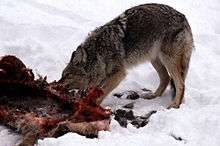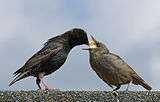Scavenger

Scavenging is both a carnivorous and a herbivorous feeding behavior in which the scavenger feeds on dead animal and plant material present in its habitat.[1] The eating of carrion from the same species is referred to as cannibalism. Scavengers play an important role in the ecosystem by consuming the dead animal and plant material. Decomposers and detritivores complete this process, by consuming the remains left by scavengers.
Etymology
Scavenger is an alteration of scavager, from Middle English skawager meaning "customs collector", from skawage meaning "customs", from Old North French escauwage meaning "inspection", from schauwer meaning "to inspect", of Germanic origin; akin to Old English scēawian and German schauen meaning "to look at", and modern English "show" (with semantic drift).
Animals
_0.jpg)
Obligate scavenging is very rare in the animal kingdom, due to the difficulty of finding enough carrion without expending too much energy. In vertebrates, only vultures and possibly some pterosaurs are obligate scavengers, as terrestrial soaring flyers are the only animals able to find enough carrion.
Well-known invertebrate scavengers of animal material include burying beetles and blowflies, which are obligate scavengers, and yellowjackets.
Most scavenging animals are facultative scavengers that gain most of their food through other methods, especially predation. Many large carnivores that hunt regularly, such as hyenas, but also animals rarely thought of as scavengers, such as African lions, leopards, jackals, and wolves will scavenge if given the chance. They may also use their size and ferocity to intimidate the original hunters (the cheetah is a notable exception). Almost all scavengers above insect size are predators and will hunt if not enough carrion is available, as few ecosystems provide enough dead animals year-round to keep its scavengers fed on that alone. Scavenger wild dogs and crows frequently exploit roadkill.
Scavengers of dead plant material include termites that build nests in grasslands and then collect dead plant material for consumption within the nest. The interaction between scavenging animals and humans is seen today most commonly in suburban settings with animals such as opossums, polecats and raccoons. In some African towns and villages, scavenging from hyenas is also common.
In the prehistoric eras, the Tyrannosaurus rex may have been an apex predator, preying upon hadrosaurs, ceratopsians, and possibly juvenile sauropods,[2] although some experts have suggested the dinosaur was primarily a scavenger. The debate about whether Tyrannosaurus was an apex predator or scavenger was among the longest ongoing feud in paleontology; however, most scientists now agree that Tyrannosaurus rex was an opportunistic carnivore, acting mostly as a predator but scavenging when it could. [3] Recent research also shows that while an adult Tyrannosaurus rex would energetically gain little though scavenging, smaller theropods of approximately 500 kg may have potentially gained levels similar to that of hyenas, though not enough for them to rely on scavenging.[4]
Animals which consume feces, such as dung beetles, are referred to as coprovores. Animals that collect small particles of dead organic material of both animal and plant origin are referred to as detritivores.
As a human behavior

In humans, necrophagy is taboo in most societies. Many instances have occurred in history, especially in war times, where necrophagy was a survival behavior.
In the 1950s, Louis Binford suggested that early humans were obtaining meat via scavenging, not hunting.[5] In 2010, Dennis Bramble and Daniel Lieberman however proposed that early humans used long-distance running to hunt, pursuing a single animal until it died of exhaustion and hyperthermia. Such behavior has been suggested as an adaptation to ensure a food supply that in turn made large brains possible.
The eating of human meat, a practice known as anthropophagy (and known across all species more commonly as cannibalism), is extremely taboo in almost every culture.
Occupation
Scavenger appears as an occupation in the 1911 Census of England and Wales. This job title was used to describe someone who cleans the streets and removes refuse, generally a workman (a modern-day garbage collector, janitor, or street cleaner) employed by the local public health authority.
Young people in developing countries revert to scavenging to develop entrepreneurship skills in order to operate in hostile economic contexts.[6][7]
In India, the term "manual scavenging" is used to the removal of raw (fresh and untreated) human excreta from buckets or other containers that are used as toilets or from the pits of pit latrines. The excreta are piled into baskets which the workers may carry on their heads to locations sometimes several kilometers from the latrines.[8] The employment of manual scavengers is officially prohibited in India since 1993 but is still taking place to this day.[9][10]
The name is properly "scavager" or "scaveger", an official who was concerned with the receipt of custom duties and the inspection (scavage) of imported goods. The "scavagers" are found with such officials of the City of London as an aleconner or beadle. These officials seem to have been charged also with the cleaning of the streets, and the name superseded the older rakyer for those who performed this duty.[11] These professions are essential to urban settings operating at the highest capacity. The garbage collection jobs and scavenging professions allow urban populations to continue unhindered by outbreaks and disease most commonly brought by the build-up of physical waste. These jobs were of the most importance before the time of functional sewer systems and indoor plumbing.
Gallery
-
Vultures feed on a carcass of a wildebeest
-

A jungle crow feeding on a small dead shark
-

Coyote feeding on an elk carcass in winter in Lamar Valley, near Yellowstone National Park
-
_scavenging_on_whale_carcass_-_journal.pone.0060797.g004-B.png)
A white shark scavenging on a whale carcass
-
_scavenging_a_narwhal_whale_(Monodon_monoceros)_carcass_-_journal.pone.0060797.g001-A.png)
A polar bear scavenging a narwhal whale carcass
-
_scavenging_on_fish_scraps_leftover_from_another_predator_-_journal.pone.0060797.g001-B.png)
An Ibiza wall lizard scavenging on fish scraps leftover from another predator
-
_feeding_on_a_dead_African_giant_snail_(Achatina_fulica)_-_journal.pone.0060797.g001-F.png)
Red weaver ants feeding on a dead African giant snail
See also
References
- ↑ Getz, W. (2011). Biomass transformation webs provide a unified approach to consumer–resource modelling. Ecology Letters, doi:10.1111/j.1461- wtf0248.2010.01566.x.
- ↑ Switeck, Brian (April 13, 2012). "When Tyrannosaurus Chomped Sauropods". Smithsonian Media. Retrieved August 24, 2013.
- ↑ Hutchinson, John (July 15, 2013). "Tyrannosaurus rex: predator or media hype?". What's in John's Freezer?. Retrieved August 26, 2013.
- ↑ Kane; et al. (2016). "Body Size as a Driver of Scavenging in Theropod Dinosaurs" (PDF). The American Naturalist.
- ↑ Binford, Louis. R. (1986) Human ancestors: Changing views of their behavior. Journal of Anthropological Archaeology 3:235-257.
- ↑ Patwary, O'Hare, Karim, Sharker (2012). "The Motivation into Young People Moving into Medical Waste Scavenging as a 'Street Career'". Journal of Youth Studies. 5 (15): 591–604.
- ↑ Entrepreneurship SKills
- ↑ "Human rights and manual scavenging" (PDF). Know Your Rights Series. National Human Rights Commission. Retrieved September 16, 2013.
- ↑ "Cleaning Human Waste: "manual scavenging", Caste and Discimination in India" (PDF). Human Rights Watch. 2014. Retrieved 23 June 2015.
- ↑ "Human rights and manual scavenging" (PDF). Know Your Rights Series. National Human Rights Commission. Retrieved September 16, 2013.
- ↑ 1911 Encyclopædia Britannica
Further reading
- Merriam-Webster's Dictionary
- Smith TM, Smith RL (2006) Elements of Ecology. Sixth edition. Benjamin Cummings, San Francisco, CA.
- Chase, et al. The Scavenger Handbook. Bramblewood Press, Santa Barbara, CA.
- Rufus, Anneli and Lawson, Kristan. The Scavengers' Manifesto. Tarcher, New York.
- "Tasmanian devil". Britannica Concise Encyclopedia. Chicago: Encyclopædia Britannica, 2009. Credo Reference. Web. 17 September 2012.
- Kruuk, H. Hunter and Hunted: Relationships between Carnivores and People. Cambridge, UK: Cambridge University Press, 2002. Print.
External links
- Stitching a Life From the Scraps of Others - slideshow by The New York Times
